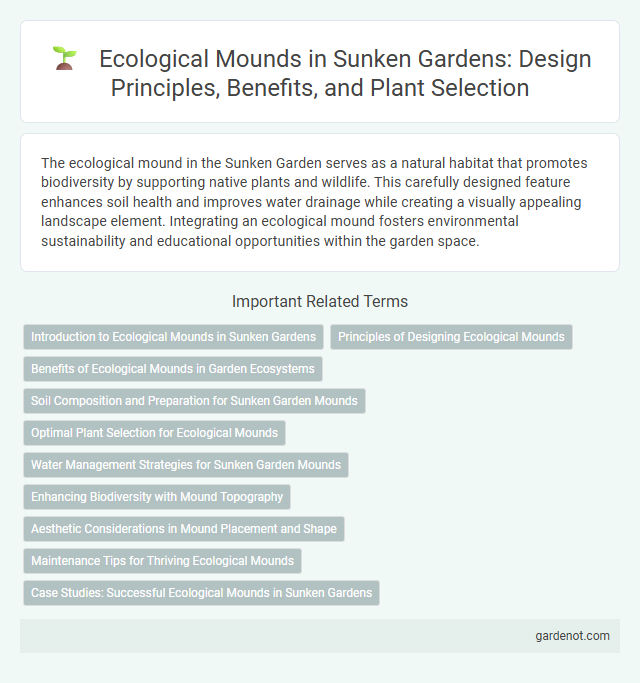The ecological mound in the Sunken Garden serves as a natural habitat that promotes biodiversity by supporting native plants and wildlife. This carefully designed feature enhances soil health and improves water drainage while creating a visually appealing landscape element. Integrating an ecological mound fosters environmental sustainability and educational opportunities within the garden space.
Introduction to Ecological Mounds in Sunken Gardens
Ecological mounds in Sunken Gardens serve as specialized habitats designed to support diverse plant and insect species by replicating natural soil and moisture conditions. These mounds enhance biodiversity by promoting native flora growth and providing shelter for pollinators and beneficial insects. Integrating ecological mounds within the garden's landscape contributes to sustainable ecosystem management and strengthens environmental resilience.
Principles of Designing Ecological Mounds
Designing ecological mounds requires prioritizing native plant selection to support local biodiversity and stabilize soil structure. Incorporating natural water flow patterns enhances nutrient cycling and prevents erosion, while varying mound shapes and slopes create diverse microhabitats for wildlife. Use of organic materials and minimal disturbance promotes sustainable ecosystem functions and long-term ecological resilience.
Benefits of Ecological Mounds in Garden Ecosystems
Ecological mounds in garden ecosystems enhance biodiversity by providing diverse habitats for insects, birds, and small mammals, promoting natural pest control and pollination. These mounds improve soil structure and water retention through layered planting, reducing erosion and supporting healthy root development. By integrating native plants, ecological mounds contribute to ecological balance and increase resilience against environmental stressors.
Soil Composition and Preparation for Sunken Garden Mounds
Sunken garden mounds require soil rich in organic matter, well-drained loam, and balanced pH levels between 6.0 and 7.0 to promote healthy root growth. Incorporating compost, peat moss, and sand enhances aeration and moisture retention, essential for sustaining diverse plant species. Proper soil preparation involves layering these components while ensuring the mound's height and slope facilitate efficient water drainage and prevent erosion.
Optimal Plant Selection for Ecological Mounds
Optimal plant selection for ecological mounds involves choosing native species with deep root systems to stabilize soil and support local biodiversity. Drought-tolerant and low-maintenance plants reduce water usage while enhancing habitat for pollinators and wildlife. Incorporating a mix of grasses, shrubs, and wildflowers ensures year-round ecological benefits and improves the resilience of the sunken garden ecosystem.
Water Management Strategies for Sunken Garden Mounds
Ecological mounds in sunken gardens optimize water management by enhancing natural drainage and groundwater recharge through strategically layered soil and native vegetation. These mounds reduce surface runoff and mitigate erosion by slowing water flow and increasing absorption capacity. Incorporating permeable materials and rainwater harvesting systems within the mound structure further supports sustainable irrigation and minimizes water loss.
Enhancing Biodiversity with Mound Topography
Ecological mounds in sunken gardens create diverse microhabitats by varying elevation, moisture, and soil composition, which support a wider range of plant and animal species. The mound topography encourages native flora growth and attracts pollinators, birds, and beneficial insects, promoting ecosystem resilience. These features enhance overall biodiversity and contribute to the ecological balance within urban green spaces.
Aesthetic Considerations in Mound Placement and Shape
The ecological mound in a sunken garden is strategically placed to enhance visual harmony and create natural focal points within the landscape. Its shape mimics organic forms, ensuring seamless integration with surrounding plant life while promoting biodiversity. Thoughtful contouring of the mound supports water drainage and soil stability, contributing to both ecological health and aesthetic appeal.
Maintenance Tips for Thriving Ecological Mounds
Regular watering ensures optimal moisture levels for ecological mounds, preventing drought stress and promoting healthy plant growth. Periodic removal of invasive species and dead vegetation maintains biodiversity and allows native flora to thrive. Applying organic mulch helps retain soil moisture, regulate temperature, and enrich nutrient content, supporting a sustainable and vibrant sunken garden ecosystem.
Case Studies: Successful Ecological Mounds in Sunken Gardens
Ecological mounds in sunken gardens enhance biodiversity by creating microhabitats that support native flora and fauna, as evidenced in the Royal Botanic Gardens at Kew and Singapore's Gardens by the Bay. These case studies demonstrate how strategic mound design improves soil drainage and promotes pollinator activity, leading to healthier plant communities. Integrating ecological mounds with sustainable garden management practices fosters resilience against climate variability and urban environmental stressors.
Ecological mound Infographic

 gardenot.com
gardenot.com